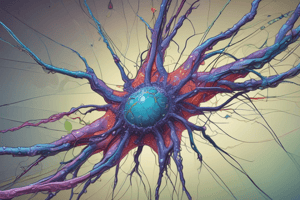Podcast
Questions and Answers
Which neuropeptide is most abundant in the intradental sensory fibers of rat molars?
Which neuropeptide is most abundant in the intradental sensory fibers of rat molars?
- Neuropeptide Y (NPY)
- Substance P (SP)
- Vasoactive Intestinal Peptide (VIP)
- Calcitonin Gene-Related Peptide (CGRP) (correct)
What effect do vasoactive peptides like CGRP and SP have when released in response to stimuli?
What effect do vasoactive peptides like CGRP and SP have when released in response to stimuli?
- Cause vasodilation. (correct)
- Produce vasoconstriction.
- Enhance sensory nerve activity only.
- Induce fibrosis in the pulp.
Which of the following methods has been shown to relieve pain in patients by affecting TRPV1 nociceptors?
Which of the following methods has been shown to relieve pain in patients by affecting TRPV1 nociceptors?
- Direct stimulation of the inferior alveolar nerve.
- Application of lidocaine.
- Administration of local anesthetics only.
- Chronic use of CAPSAICIN ointment. (correct)
⭐️What is the relationship between sympathetic AGONist(如:血管收縮 contrcition 劑 epinephrine in 麻藥 ) and CGRP release in dental pain management?
⭐️What is the relationship between sympathetic AGONist(如:血管收縮 contrcition 劑 epinephrine in 麻藥 ) and CGRP release in dental pain management?
What triggers the release of neuropeptides from intradental sensory fibers?
What triggers the release of neuropeptides from intradental sensory fibers?
What does neurogenic inflammation refer to in the context of dentin stimulation?
What does neurogenic inflammation refer to in the context of dentin stimulation?
What is the effect of capsaicin on TRPV1-expressing C and A-delta nociceptors?
What is the effect of capsaicin on TRPV1-expressing C and A-delta nociceptors?
What condition is associated with elevated concentrations of CGRP, SP, and NKA in human teeth?
What condition is associated with elevated concentrations of CGRP, SP, and NKA in human teeth?
Flashcards are hidden until you start studying
Study Notes
Neuropeptides in Pulp Biology
- Neuropeptides are abundant in pulpal nerves.
- Key neuropeptides include CGRP, SP, NPY, NKA, and VIP.
- CGRP is the most prevalent neuropeptide in intradental sensory fibers of rat molars.
- Stimuli for neuropeptide release include tissue injury, complement activation, antigen-antibody reactions, and antidromic stimulation of the inferior alveolar nerve.
- Vasoactive peptides like CGRP and SP induce vasodilation similar to histamine and bradykinin.
- SP and CGRP contribute to inflammation and wound healing.
- Sympathetic agonists and antagonists can modify CGRP release, potentially leading to treatments for dental pain.
- Vasoconstrictors in local anesthetics may directly inhibit dental nerve activity, contributing to pain reduction.
- Capsaicin activates and chronically blocks TRPV1-expressing nociceptors in dental pulp, suggesting potential for chronic pain relief.
- Mechanical stimulation of dentin causes vasodilation through neuropeptide release.
- Electric stimulation of teeth also triggers vasodilation.
- Elevated concentrations of CGRP, SP, and NKA are found in painful human teeth compared to healthy teeth.
- These peptides are also elevated in pulps beneath carious lesions.
Studying That Suits You
Use AI to generate personalized quizzes and flashcards to suit your learning preferences.




